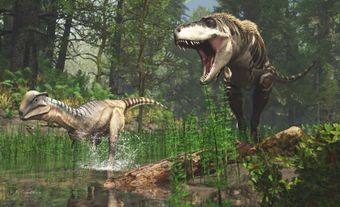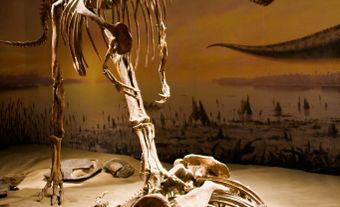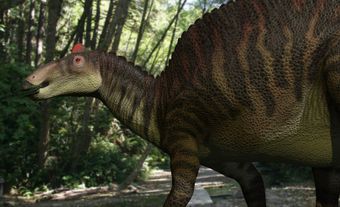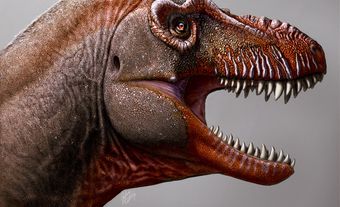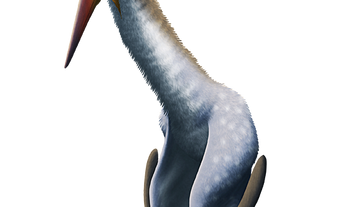Saurornitholestes (pronounced SORE-or-NITH-oh-LESS-teez) is a genus of small, meat-eating dinosaurs. It is part of a group of dinosaurs called dromaeosaurids, which are often referred to as “raptors” in popular culture. It lived between 76.5 and 74.8 million years ago in southern Alberta and northern Montana. Saurornitholestes is similar in size to its close cousin Velociraptor from Mongolia. The first specimen of Saurornitholestes, a partial skeleton of a small individual, was discovered in Dinosaur Provincial Park in southern Alberta in 1974 and described in 1978. Larger specimens were later discovered in the Milk River Natural Area of southernmost Alberta and in Montana. In 2014, a nearly complete skeleton of Saurornitholestes was discovered in Dinosaur Provincial Park. This makes Saurornitholestes the most complete dromaeosaurid known from Canada and one of the most complete from North America. ( See also Dinosaurs Found in Canada.)
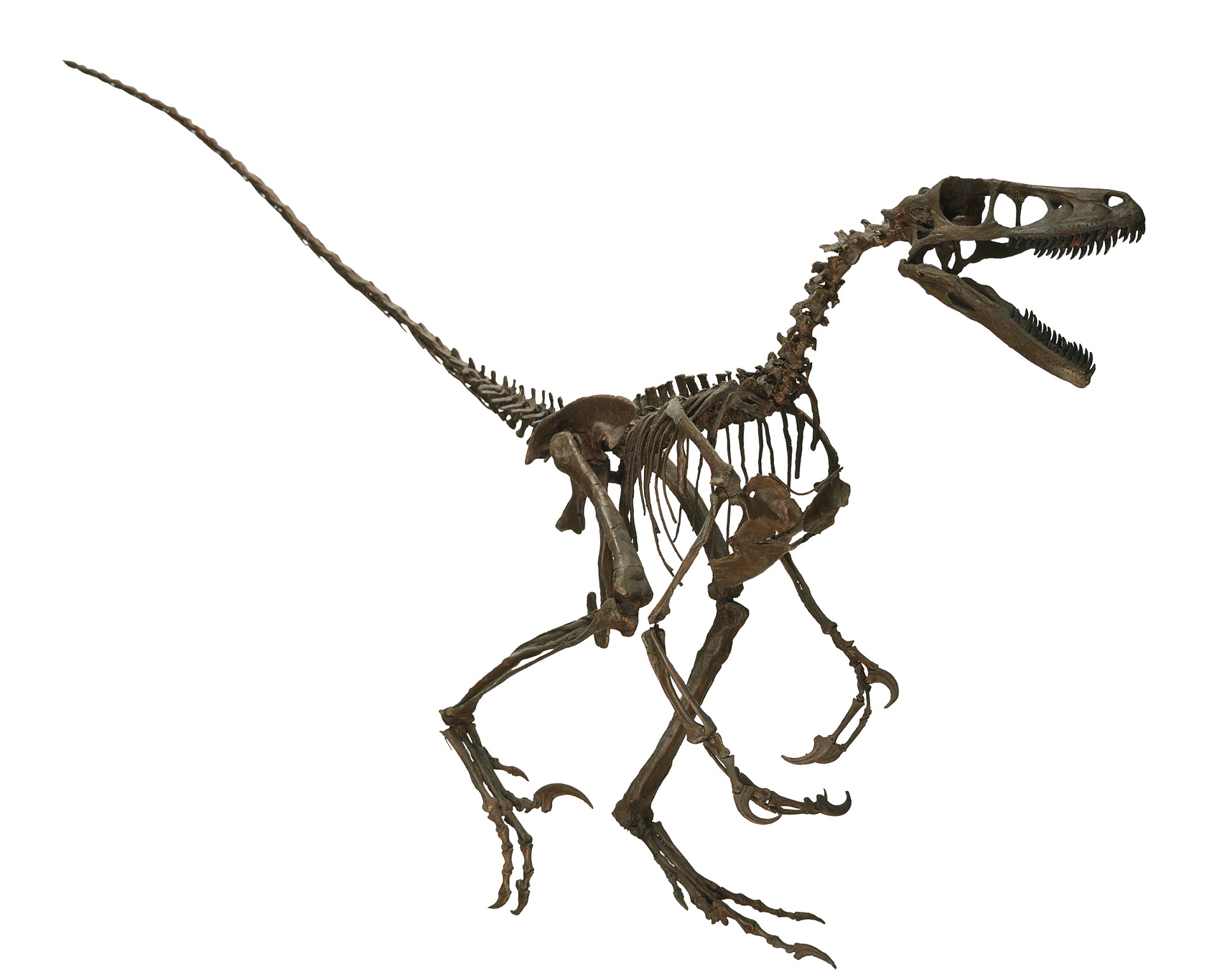
Description
Walking on two legs, Saurornitholestes measured approximately 2.2 m long, was 60 cm tall at the hip and weighed 8.5 kg. It was roughly the same size as its famous cousin Velociraptor, but its skull was shorter, taller and wider than the latter.
Like other dromaeosaurids, Saurornitholestes had a long tail stiffened by long bony rods; long, clawed hands that were nearly half the length of its arms; and a large sickle claw on its second toe. Its teeth were blade-like in order to slice through flesh. In addition, the base of the upper front teeth curved inward and they had pronounced ridges and flutes along their length, potentially an adaptation for preening feathers and grooming.
Although primitive hair-like feathers, modern feathers, and even wings were present in early dromaeosaurids, no evidence of feathers has been found so far in Saurornitholestes. However, little bony knobs have been found on the ulna (forearm bone) in Velociraptor, which paleontologists have interpreted as the attachment sites of wing feathers. It is therefore likely that Saurornitholestes was also covered with feathers and had wings.
Range and Habitat
Fossil remains of Saurornitholestes have been found in the Dinosaur Park Formation of southern Alberta, in the upper Oldman Formation of southernmost Alberta, and in the upper Two Medicine Formation of Montana. It lived between 76.5 and 74.8 million years ago. Saurornitholestes inhabited the subtropical western coastal plain of the Western Interior Seaway, an inland sea that connected the modern-day Arctic Ocean to the Gulf of Mexico, dividing North America in two. It lived during a time when sea levels were rising and the shoreline of the Western Interior Seaway was moving westward from modern-day Saskatchewan.
Reproduction and Development
Paleontologists discovered a nest with eggs that may have belonged to Saurornitholestes in the upper Two Medicine Formation of Montana. The nest contained a minimum of 12 oval eggs, each 12.5 cm long and 6 cm wide. The eggshell was not smooth like that of modern birds, but covered with small ridges that split and merged with one another. The eggs were laid in pairs and arranged in a circle around a flat, central mound of sand, with the narrow end of each egg pointing down. Paleontologists believe that the mound was built by a parent to allow it to sit on the nest in order to keep the eggs warm. They did not discover skeletal remains of embryos or of a parent with the nest; however, the internal structure of the eggshells and the arrangement of the eggs suggests that it was produced by a dromaeosaurid. Paleontologists believe the nest could have been made by Saurornitholestes because it is one of only two species of dromaeosaurids known from the Two Medicine Formation.

Diet
Saurornitholestes, like all dromaeosaurids, was carnivorous. Tooth marks on bones and shed teeth left by dromaeosaurids indicate they frequently fed on large herbivorous dinosaurs. Paleontologists have found a Saurornitholestes tooth embedded in a wing bone of the giant pterosaur Cryodrakon, indicating that this dromaeosaurid also scavenged on pterosaurs. Given its size, it is also likely that Saurornitholestes hunted small prey, like lizards, mammals and small-to-medium dinosaurs.
Behaviour
Although popular media often portray dromaeosaurids as hunting in packs, little paleontological evidence supports that hypothesis. Study of the isotopic composition of dromaeosaurid teeth indicate that young individuals ate different food than adults and that their diet changed as they grew, suggesting dromaeosaurids lived alone and did not hunt in packs. The best line of evidence suggesting that dromaeosaurids were gregarious comes in the form of trackways that show up to six individuals walking as a group. When dromaeosaurids walked, they kept their sickle claw lifted up so it would not touch the ground, leaving a distinctive two-toed footprint in the sediment.
Because dromaeosaurids had relatively weak bites, on par with Komodo dragons, they likely used their long, clawed hands and the sickle claw on their feet to grasp and slash prey. The discovery of the “fighting dinosaurs” in Mongolia supports this interpretation. The “fighting dinosaurs” are Velociraptor and Protoceratops skeletons preserved in a deadly embrace. One hand of the predator (Velociraptor) is grasping the head of its prey (Protoceratops), while the Velociraptor's sickle claw is situated in the neck of the Protoceratops. Saurornitholestes bit down on its prey and ripped flesh off carcasses by forcefully pulling back with its jaws closed.
Based on its large olfactory bulbs, paleontologists believe that Saurornitholestes had a very keen sense of smell, which it potentially used to track prey or patrol large territories.
Discovery
Because their bones are small, hollow and fragile, complete skeletons of dromaeosaurids are very rare. Most often, they are known from isolated bones and teeth. Amateur paleontologist Irene Vanderloh discovered the first specimen of Saurornitholestes, a partial skeleton of a small individual, in 1974 in Dinosaur Provincial Park in southern Alberta. The specimen was described in 1978. Its species name, langstoni, honours paleontologist Wann Langston Jr. Later finds made by paleontologists include an articulated tail discovered in 1982 in Dinosaur Provincial Park, partial skeletons from southernmost Alberta and from Montana discovered in the late 1980s and 1990s, and finally a nearly complete skeleton from Dinosaur Provincial Park discovered in 2014. This makes Saurornitholestes the most complete dromaeosaurid known from Canada and one of the most complete from North America.
Although isolated teeth attributed to Saurornitholestes have been discovered throughout North America in rock formations spanning the last 20 million years of the Cretaceous period, subtle differences in shape indicate that they actually belonged to different dromaeosaurid species.

 Share on Facebook
Share on Facebook Share on X
Share on X Share by Email
Share by Email Share on Google Classroom
Share on Google Classroom
